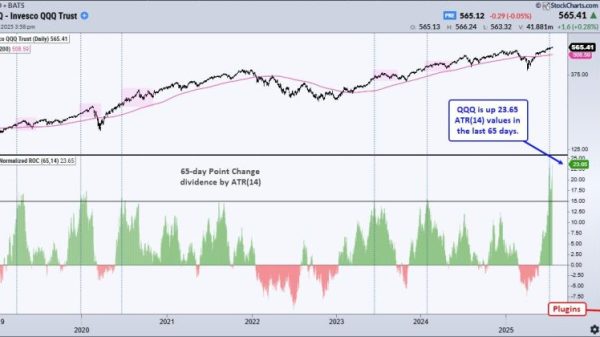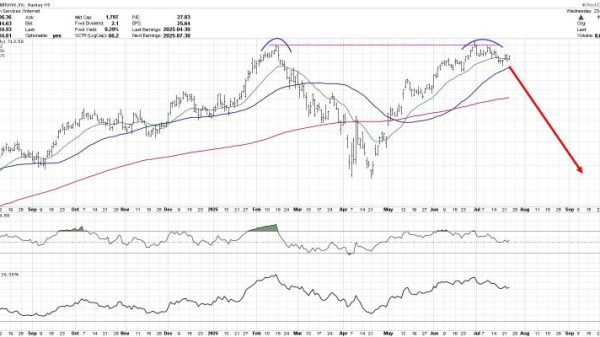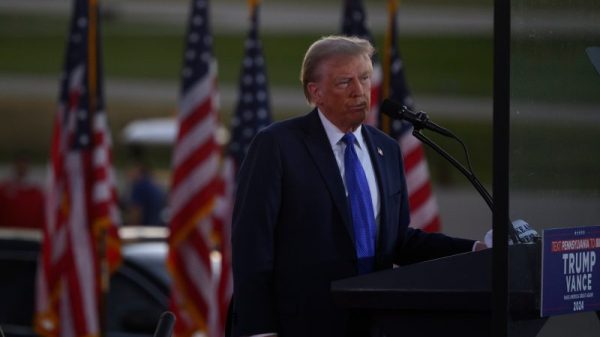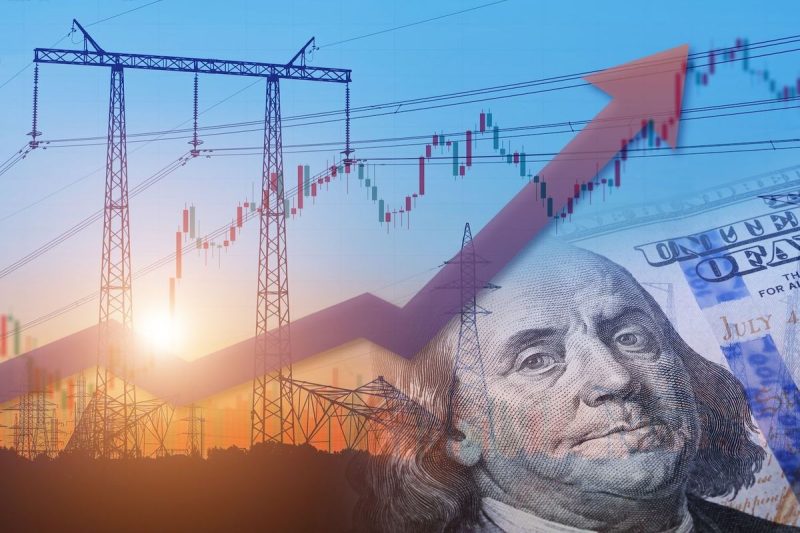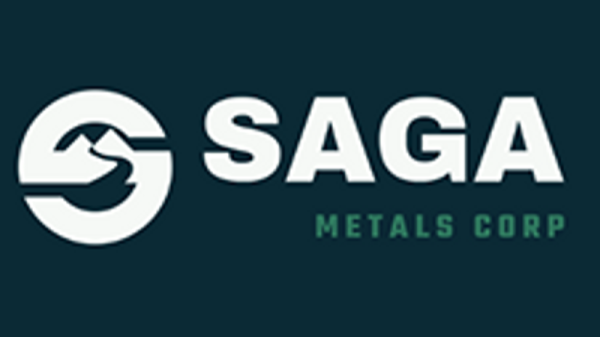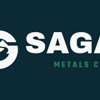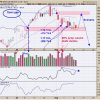Impacted by broad uncertainty, geopolitical risks and trade tensions, spot U308 prices fell 13.26 percent during Q1 2025, starting the session at US$74.74 per pound, and contracting to US$64.83 by March 31.
As factors outside the uranium market forced the spot price consolidation, the long term price remained steady holding at the US$80.00 level, a potential indicator of the market’s long term growth forecast.
Despite positive long term fundamentals propelling U308 spot prices to nearly two decade highs in 2024, the market has been unable to find continued support in 2025.
Much of the uncertainty has been introduced from the on and off and on again tariffs implemented by the Trump administration, which infused the already opaque uranium market with even more ambiguity.
As volatility rattles investors, US utility companies have also been impacted by the threat of first a 25 percent and then 10 percent tariff on uranium imports from Canada.
Jander questioned the motive behind tariffing a long standing ally, especially when the domestic sector is unable to satiate the national need.
“Does it make sense for the US to put tariffs on Canadian material, who is their best friend?” he asked rhetorically. “I don’t think so, because the US produces 1 million pounds a year. They need about 45 to 50 million pounds per year. So it feels like they’re just punishing themselves.”
With investors and utilities sidelined, U3O8 prices sank to an almost three year low of US$63.44 per pound on March 12, well off the 17 year high of US$105 per pound set in February 2024.
Chronic undersupply meets rising demand
The tailwinds that bolstered prices above the US$100 per pound level, largely remain intact, despite being faced with Trump’s trade tensions. Some of those drivers include the growing supply deficit.
According to the World Nuclear Association (WNA), in 2022 total mined supply only met 74 percent of global demand, a disparity that is still persistent, and growing.
“This year, uranium mines will only supply 75 percent of demand, so 25 percent of demand is uncovered,” Amir Adnani, CEO and president of Uranium Energy (UEC) (NYSEAMERICAN:UEC) said at VRIC 2025 in January.
Adnani went on to explain that after enduring nearly two decades of underinvestment, the uranium sector is grappling with one of the most acute supply deficits in the broader commodity space.
Unlike typical resource markets, where price surges prompt swift production responses, uranium has remained sluggish on the supply side, despite prices jumping 290 percent over the past four years.
According to Adnani this chronic underproduction stems from 18 years of depressed pricing and lackluster market conditions, which discouraged new mine development and shuttered existing operations.
“The fact that we’re not incentivizing new uranium mines simply means the commodity price isn’t high enough,” he said, of the US$74 per pound spot price.
Now with prices holding in the US$64 range, new supply is even less likely to come online in the near term, especially in Canada and the US.
Meanwhile, demand is set to steadily increase.
“Next year, uranium demand is going up because there are 65 reactors under construction, and we haven’t even started talking about small and advanced modular reactors,” said Adnani. “Small and advanced modular reactors are an additional source of demand that maybe not next year, but within the next three to four years, can become a reality.”
Supply setbacks mount
With prices sitting well below the US$100 per pound level – which is widely considered the incentive price – future supply is even more precarious.
Guidance reductions from uranium majors is only compounding the challenges on the supply side, but may be a potential price catalyst.
In 2024, Kazatomprom (LSE:KAP,OTC Pink:NATKY), the world’s largest uranium producer, revised its 2025 production forecast downward by approximately 17 percent, now projecting output between 25,000 and 26,500 metric tons of uranium.
This adjustment from the earlier estimate of 30,500–31,500 metric tons is attributed to ongoing challenges, including shortages of sulphuric acid and delays in developing new mining sites, notably at the Budenovskoye deposit.
In January, a temporary production suspension at the Inkai operation in Kazakhstan further threatened 2025 supply. The project, a joint venture between Kazatomprom and Cameco (TSX:CCO,NYSE:CCJ), was halted in January due to paperwork delay.
– YouTube
Rick Rule discusses his expectations for the resource sector in 2025.
While the news was a blow to the uranium supply picture, as veteran resource investor and proprietor of Rule Media, Rick Rule pointed out at VRIC 2025, the move could benefit the spot price.
“The thing that’s happened very recently that’s very bullish for uranium is the unsuccessful restart of Inkai, which I had believed to be the best uranium mine in the world,” said Rule in the January interview.
He continued: “At the time that it was shut down, it was the lowest cost producer on the globe, because of many things, including an unavailability of sulfuric acid in Kazakhstan, that mine hasn’t resumed production anywhere near at the rate that I thought it would. So there’s 10 million pounds in reduced supply in 2025 and the spot market is already pretty skinny.”
At the end of January production resumed at Inkai, however as Rule pointed out the mine failed to reach its projected output capacity in 2024, producing 7.8 million pounds U3O8 on a 100 percent basis, a 25 percent decrease from 2023’s 10.4 million pounds.
AI boom and clean energy push set stage for surge in uranium demand
Global uranium demand is projected to rise significantly over the next decade, driven by the proliferation of nuclear energy as a clean power source. According to a 2023 report from the WNA, uranium demand is expected to increase by 28 percent by 2030, reaching approximately 83,840 metric tons from 65,650 metric tons in 2023.
This growth is fueled by the construction of new reactors, reactor life extensions, and the global shift towards decarbonization. The rapid expansion of artificial intelligence (AI) is set to significantly increase global electricity demand, particularly from data centers.
“Electricity demand from data centres worldwide is set to more than double by 2030 to around 945 terawatt-hours (TWh), slightly more than the entire electricity consumption of Japan today,” an April report from the International Energy Agency notes. “AI will be the most significant driver of this increase, with electricity demand from AI-optimised data centres projected to more than quadruple by 2030.”
Nuclear energy is poised to play a crucial role in boosting global electricity production.
A recently released report from Deloitte indicates that new nuclear power capacity could meet about 10 of the projected increase in data center electricity demand by 2035.
However, “this estimate is based on a significant expansion of nuclear capacity, ranging between 35 gigawatts (GW) and 62 GW during the same period,” the market overview states.
While the more than 60 reactors under construction will meet some of this heightened demand, additional reactors and more uranium production will be needed to sustainably increase nuclear capacity.
Add to this the gradual restart of Japanese reactors and the disparity between supply and demand deepens. By the end of 2024 Japan had successfully restarted 14 of its 33 shuttered nuclear reactors, which were taken offline in 2011 following the Fukushima disaster.
Long-term upside remains intact
Although positive long term demand drivers paint a bright picture for the uranium industry, the current trade tensions from Trump’s tariffs have shaken the market.
Despite these challenges equities are still positioned to profit from the underlying fundamentals.
“I think that speculative fever is gone,” he said. The prices have normalized, consolidated. They haven’t been terrible performers, but they’ve consolidated, and I think they’re now ready for their next leg higher.”
This sentiment was reiterated by Sprott’s ETF product manager, Jacob White, who underscored the ‘buy the dip’ potential of the current market.
“We believe today’s price weakness presents a potentially attractive entry opportunity for investors who appreciate the strategic value of uranium and can weather near-term turbulence,” wrote White.
Securities Disclosure: I, Georgia Williams, hold no direct investment interest in any company mentioned in this article.






